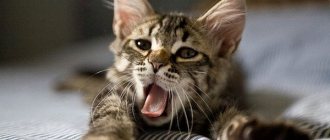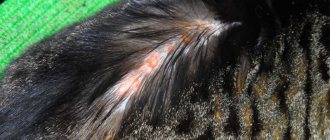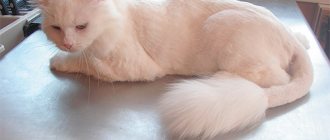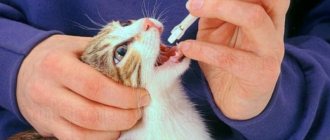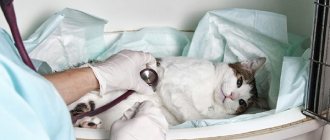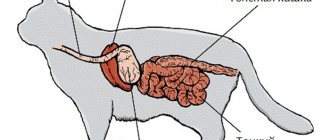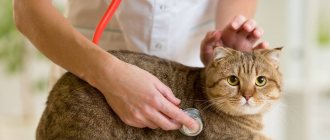Calicivirus infection is a common reason for visiting a veterinarian. This is one of the most dangerous diseases, and in order to save your pet’s life, an integrated approach to its treatment is necessary.
Information about symptoms and preventive measures will teach the cat owner to promptly recognize the pathology and reduce the risk of infection to other pets.
Causes of calicivirus in cats
The development of calicivirus is caused by strains of a cubic RNA virus – Feline Calicivirus.
Calicivirus in cats is an infectious pathology of viral origin.
The pathogen affects the entire cat family, regardless of age and breed; young animals and animals under 2 years of age show the greatest sensitivity to infection.
The microorganism is stable in the external environment: outside the host it can exist for up to 10 days, which leads to the rapid spread of the disease.
Important! Caliciviruses are difficult to inactivate with many disinfectants, but they are destroyed quickly when exposed to bleach.
The disease often develops during cold periods, as the body's natural resistance decreases.
Other factors of infection are:
- lack of vaccination;
- crowded keeping of animals in nurseries;
- insufficient ventilation in the room.
When cats are kept in groups, the disease is quickly transmitted and periodically manifests itself in outbreaks of infection.
Attention! The FCV virion does not have strong activity, and the pathology is often hidden. But when other infectious agents (mycoplasmas, viruses or bacteria) join in, the breeder can lose up to 80% of valuable animals.
Incubation period and duration of the disease
The latent period lasts 5 days, after which pronounced symptoms appear, progressing every day. The duration of treatment is up to 24 days. After this, the stage of recovery begins, and it is possible to carry the virus for a long period of time or throughout life. The infection is transmitted by airborne droplets and has the specificity of maintaining vital activity for up to 1 day outside the cat’s body. Even after complete recovery, the cat can continue to release the virus into the environment for 2 months. Symptoms of the disease may not appear in the animal itself, but the cat will be dangerous to surrounding cats for about 30 days.
When a cat suffers from a simple type of illness, the disease goes away within 14 to 20 days, without intervention.
Symptoms of calicivirus in cats
Having penetrated the body, microorganisms actively multiply on the mucous membrane of the cat’s mouth, in the submandibular lymph nodes and the epithelium of the tonsil crypts.
Symptoms of calcivirosis can appear in any combination
The incubation period is determined by the resistance of the immune system and the virulence of the strain; it generally lasts 2-10 days, sometimes extending to 20 days.
The disease is manifested by an increase in temperature to 40.5 C°, fever is observed for 3 or 4 days.
Symptoms of the disease depend on age and immune status and are characterized by:
- depressed state of the animal;
- refusal of food;
- coughing and sneezing;
- discharge from the nasal cavity and eyes;
- the appearance of small bubbles up to 1 mm on the mucous membranes of the mouth: on the sides of the tongue, on the palate;
- drooling.
Be sure to read:
How to identify rabies in a cat at an early stage, the first signs
When affected by certain types of virions in cats, arthritis develops against a background of severe symptoms.
Gradually, the bubble elements spread to the nostrils. Over time, the formations burst, transform into erosions, which gradually deepen and ulcerate.
Important! Certain strains of calicivirus infection are able to penetrate the lungs of animals. They multiply in the epithelial cells lining the alveoli, causing necrosis and the formation of pneumonia.
The duration of acute symptoms is from 1 to 4 weeks, the surface of the mucous epithelium is gradually regenerated, and if left untreated, 30% of animals die.
Oral ulcers are the first sign of calcivirosis
In kittens up to 6 months of age, the disease often manifests itself with nonspecific signs; along with damage to the mucous membrane, the following are observed:
- vomiting and diarrhea;
- depressed state;
- rapid breathing;
- wheezing.
The examination reveals inflammation of the respiratory tract, pneumonia, which increases the risk of death of the animal.
Important! Up to 3-4 months, when the colostral immunity transmitted from the mother cat ends, the infection can affect the brain and be accompanied by seizures. Death occurs within 3-7 days.
Outcome of the disease
When kittens are infected with calcivirus, about 80% of them do not survive. The high mortality rate is due to the incubation period, which lasts 24 hours. If a young cat with a relatively strong body gets sick, recovery occurs in 70% of cases. Old and weakened cats have a 50% survival rate. Remember that prompt treatment of calcivirus in cats increases the chances of recovery.
A cat who has recovered from the disease can get a calcivirus infection again. Secondarily, the disease occurs in a mild form, accompanied by the formation of ulcers on the tongue and palate and conjunctivitis. A relapse or chronic course of the disease is also possible - the signs are the same as for re-infection.
How to treat calicivirus
Calcivirosis on the nose and eyes
No specific drugs have been developed against calicivirus ; treatment uses methods aimed at eliminating the symptoms of the disease, as well as at preventing and treating secondary inflammations that develop as a result of the addition of pathogenic microflora.
What medications does the veterinarian prescribe?
- Antiviral agents. Vitafel serum, Anandin or Fosprenil injections are used.
- Antibiotics . Indicated to prevent the development of secondary (secondary) infection, they include medications with a wide range of effects on microorganisms (Flemoxin, Azithromycin, cephalosporins).
- Immunostimulants . Required to activate the immune response (Immunofan).
- Immunomodulators . For persistent ulcerative lesions (Cycloferon).
- Antiseptics . Solutions of Furacilin, Miramistin or Vinilin are used to treat ulcers on the nose and oral mucosa.
- Eye drops and ointments. For eye inflammation, use Tobrex, Bars drops, and tetracycline ointment.
- Anti-inflammatory drugs . Medicines are recommended for arthritis (Ketofen, Loxicom).
Be sure to read:
Colds in cats: symptoms and treatment, causes of the disease, how to determine whether it is transmitted to humans
To prevent dehydration and to restore the animal's strength, solutions of glucose, Ringer-Locke, Catozal or Gamavit, as well as vitamins C and B are administered.
What drugs for calicivirus can be combined
Various medications are used to treat the disease; a competent combination of drugs ensures the cat’s recovery.
How the drugs are combined:
- Systemic antibacterial agents (Fosprenil) are combined with drugs that regulate local immunity (Maksidin).
- Lozeval is prescribed internally, and the immunomodulator Maxidin or an antimicrobial solution (Miramistin, Tsiprovet) is applied to the ulcers.
- Fosprenil injections are used in parallel with local antimicrobial medications (Tsiprovet drops)
- The drug Tsiprovet can be given to a cat simultaneously in the form of tablets and the solution applied to the affected mucous membrane; sometimes the liquid product is replaced with Maxidin.
If the pet does not eat, additional droppers with infusion solutions are prescribed.
Important! The treatment regimen is selected by the veterinarian, taking into account the severity of the disease.
Treatment at home
For non-severe forms of the disease, the cat can be treated at home. The cat needs to be isolated from other animals. Use medications every day strictly as prescribed by the doctor, also clean your nose and eyes with antibiotics, sanitize the oral cavity, rinse ulcers with medications and or chamomile decoction.
Be sure to administer Ringer's solution, sodium chloride, or glucose if there are signs of dehydration.
You need to monitor your pet’s diet, as this gentle food, rich in vitamins, guarantees your pet’s quick recovery.
Complications after calcivirosis
Frequent complications (in 30% of patients with feline calcivirus) are:
- Secondary bronchitis;
- Bronchopneumonia;
- Atelectasis;
- Increased nervous excitability;
- Twitching of limbs, convulsions;
- Weakening of the immune system;
- Brain damage.
Timely treatment will reduce the likelihood of serious complications that threaten the life of your beloved furry.
Caring for a sick animal
The treatment regimen is selected by a veterinarian.
The sick cat is isolated and the living conditions are improved as much as possible. They provide food with a balanced composition and a soft consistency, since the animal experiences pain when chewing.
A special diet is not required, but the food must be high in calories. Fasting during calicivirus is dangerous, so it is recommended to offer attractive food. If the animal does not eat on its own, the food is forcibly administered with a syringe, calculating the dose based on the daily weight requirement.
How to make sure that your cat remains a carrier of calicivirus
In 15% of cases, the disease becomes chronic ; the presence of infection is manifested by persistent inflammation of the oral mucosa and gums. Treatment gives short-term results, but soon the disease develops again, leading to tooth loss even in young animals.
Be sure to read:
Hepatitis in cats: symptoms and treatment, forms, medications and folk remedies, is it contagious?
Since there is no medicine that acts on the virus, animals are recommended to be treated with interferons : Reaferon and Roncoleukin.
The drugs have immunomodulatory and antiviral effects; they are used once a quarter to prevent kidney damage.
How does infection occur and how to avoid it?
Since there is no medicine that acts on the virus, interferon therapy is recommended for animals.
Sick animals and carriers of the virus secrete the pathogen through nasal discharge, saliva, tear secretions and feces for several months.
Ways of infection of cats;
- direct contact;
- through the mouth;
- aerogenic.
The virus is transmitted through household items and remains on the owner’s skin if he has petted an infected animal. As a result, the disease can affect pets that are not allowed to go for walks.
Compliance with sanitary and hygienic standards and preventive measures help to avoid infection:
- exclude contact with stray cats;
- fight against parasites in a timely manner;
- isolate pregnant animals and offspring before vaccination;
- avoid crowding.
When keeping several pets together, the premises, dishes, and trays are regularly disinfected.
Attention! Cats with respiratory tract damage are not allowed to reproduce.
Vaccination
Methods of specific prevention of calicivirus include vaccination. Multicomponent vaccines Multifen-3 and 4, Felovax-4, Nobivac Tricat Trio, Nobivac Forcat have been created for cats. The drugs are additionally active against chlamydial infection, feline distemper and rhinotracheitis.
Important! Only healthy cats are vaccinated after deworming.
Kittens are vaccinated for the first time at 8-12 weeks, revaccination is carried out after 3-4 weeks. Resistance to the virus develops after 14 days. To develop immunity to the disease, vaccinations are given annually.
